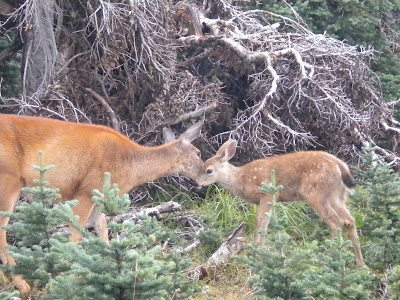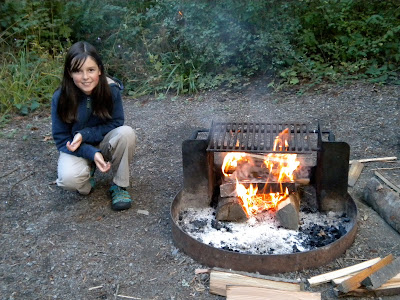Our first day in the park one of the clearest they had seen in days, and we were able to glimpse some amazing views from Hurricane Ridge. Here's Adalaya with the Olympic Mountains in the background. Unfortunately, the highest peak of the range, Mt. Olympus, was still elusive amidst the clouds, but it is located behind (and above) these jagged peaks. You'll have to use your imagination like we did.

This was a nice view across the Strait of Juan de Fuca to Van Couver Island and Victoria, whence we had just come.

We also saw this cute fawn and doe black-tailed deer.

And many grouse.

Adalaya made her first fire all by herself that evening. A roaring success!

Next we visited the western slope of the Olympics, which receives an average of 12 FEET of rainfall each year because of its location between the Pacific Ocean and the Olympic Mountains. The Hoh Rain Forest is like nothing I've ever seen before. Extremely mossy and green. Amazingly beautiful!

Huge trees too! Here's a Douglas Fir that gives a whole new perspective on our little NC Christmas trees.

And huge banana slugs! This one's 4-5 inches long. They come in all kinds of colors and patterns.

Everything that doesn't move gets covered around here.

Because of its unique location and profuse moss cover, this rain forest is home to quietest spot in the lower 48 states. Free of human generated noise, that is. At the outset of our trip, George read One Square Inch about the author's quest to find "one square inch" of natural silence. The only place he was able to find natural silence for at least 15 minutes was in the Hoh Rain Forest. We entered through the "portal of silence" and found the red stone that commemorates the spot, and we sat silently and enjoyed the natural quiet.


On the 3 mile journey back we walked without talking, separated from each other enough to be just out of sight so we could continue to enjoy the peaceful quiet.

The final ecosystem left to explore in the park was the coast. Here is our first glimpse of the Pacific Ocean.

It's official, we've traveled from sea to shining sea!

And look at the treasures we found. . .







No comments:
Post a Comment